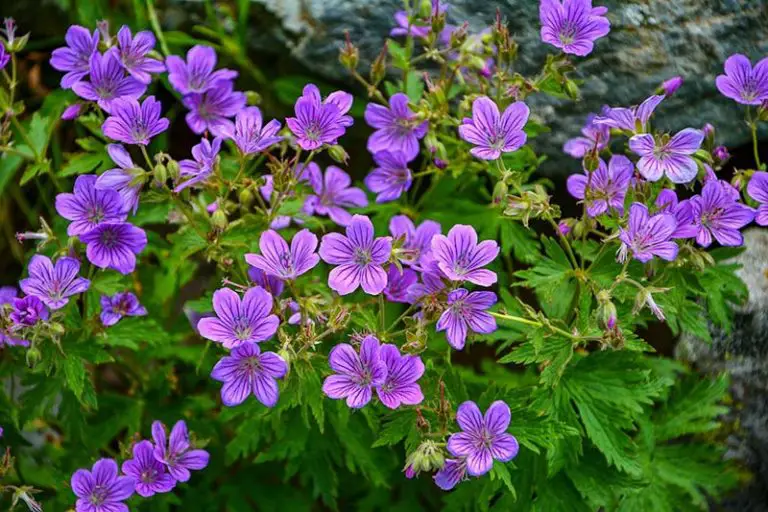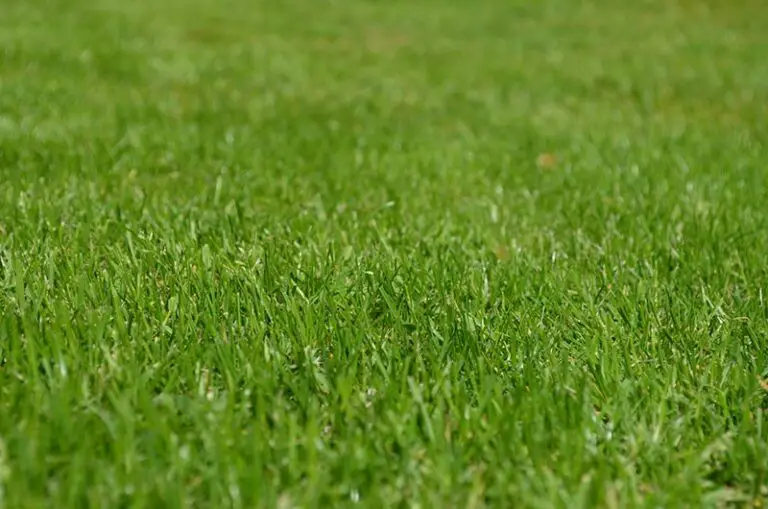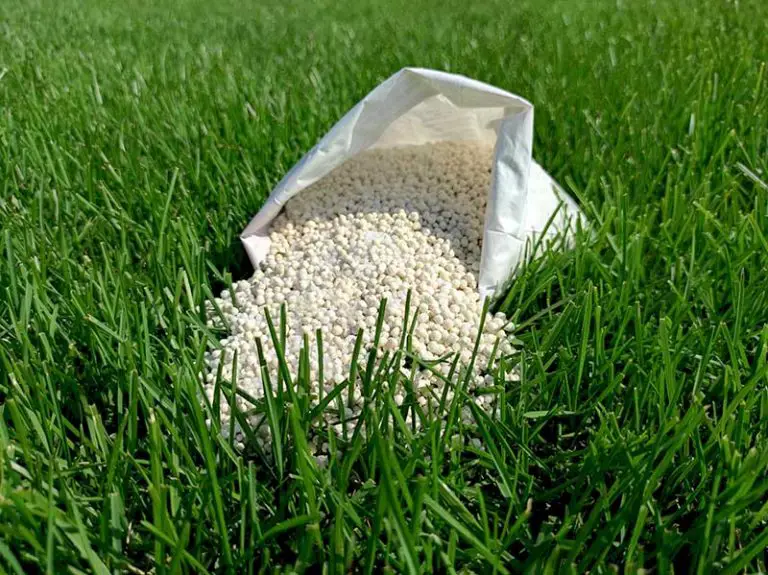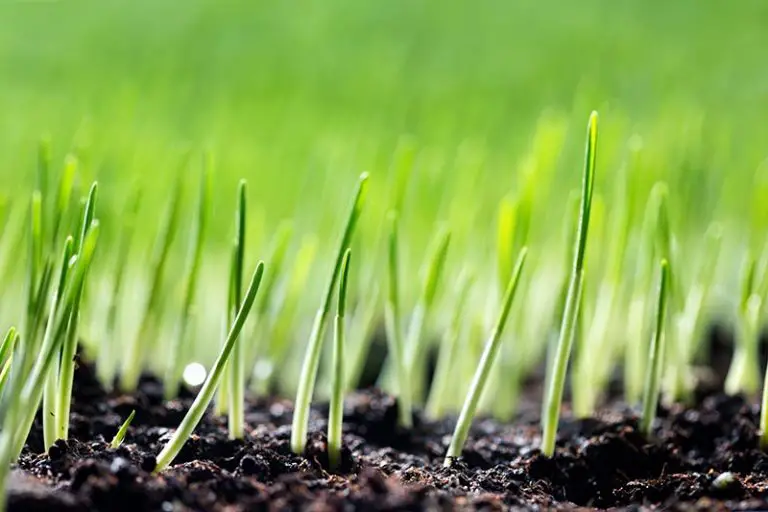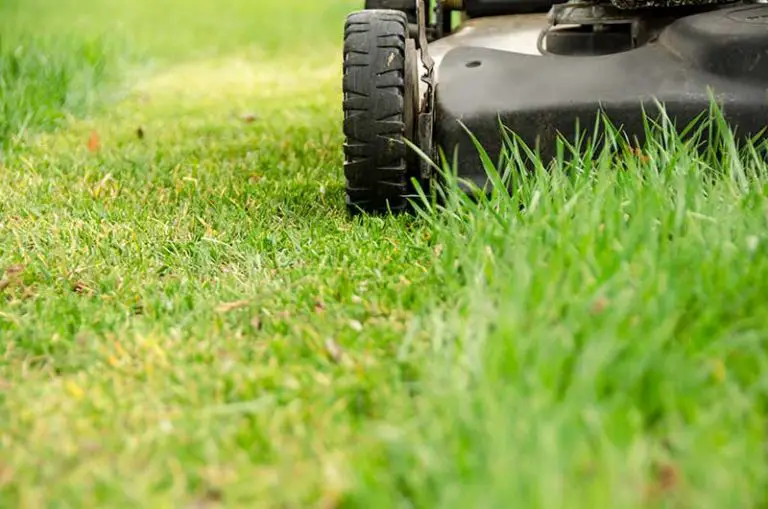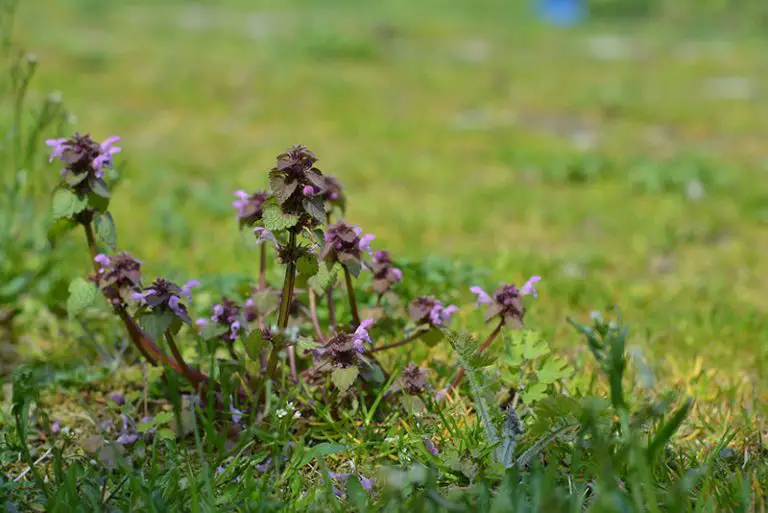Can You Mow Over Leaves? (Benefits of Leaf Mulch)
As beautiful as your yard can be during the fall, one of mother nature’s least welcome gifts are the swathes of leaves that fall on your lawn at this time of year. Even if you don’t mind them aesthetically, letting those leaves pile up on your lawn can result in smothered grass and leaves it more susceptible to the development of disease.
In short, yes, you can mow over leaves, and this is actually a recommended practice to carry out during the fall. By mowing over the leaves and reducing them in size, you can provide your lawn with an organic batch of fertilizer, mulch, and weed control for free, using relatively little effort compared to other methods of leaf removal.
Why Should You Remove Leaves From Your Lawn?
It’s a bad idea to let fallen leaves sit on your lawn for a number of reasons. Firstly, heavy piles of leaves can smother your grass, blocking sunlight and air circulation around your lawn. This can encourage the development of fungal lawn diseases such as brown patch disease or dollar spot fungus.
On top of this, a thick layer of leaves on the lawn will cause the turf to stay moist for long periods of time. This not only further encourages the development of fungal lawn diseases, but may also cause root rot in your turf. In summary, letting leaves pile up on your lawn is likely to leave you with patches of yellow, brown, or completely dead grass.
When Should You Remove Leaves From Your Lawn?
You should remove leaves when they start to pile up significantly on your lawn. A few leaves here and there are unlikely to cause any major issues, but large or heavy piles of leaves will. Generally speaking, you should remove leaves when they cover the top half of your grass blades, or when they’re covering over ⅓ of your overall lawn.
If a large number of leaves drop on your lawn over a few days due to a rapid cold snap, wait until the lawn is covered with a single layer. Regardless of whether you mow over the leaves or rake them up, make sure to remove them before it rains. The precipitation will cause the leaves to clump together, making any removal effort much more of a challenge. Lawn mowers have a harder time chopping up wet leaves, and they will also clog leaf rakes or vacuums.
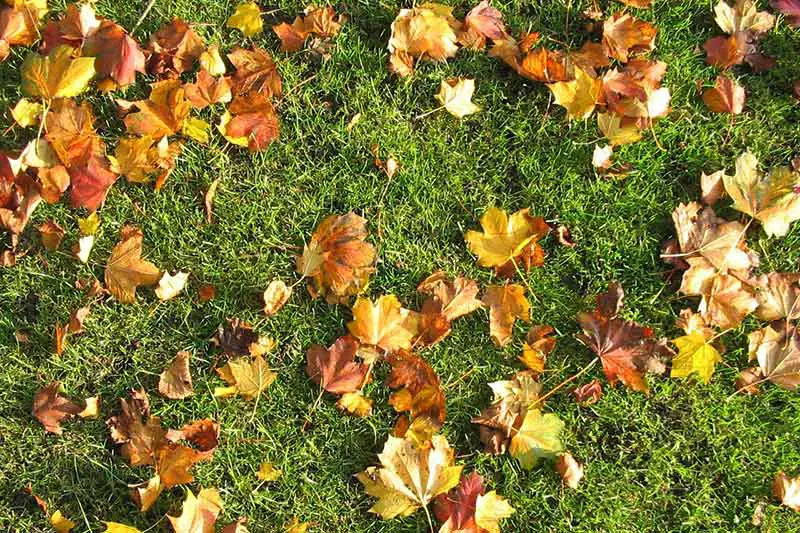
Should You Mow Over Leaves or Rake them Up?
While raking the leaves off your lawn is an effective method of removal, it isn’t the optimal method compared to mulching them with a lawn mower. Not only is mowing over the leaves less time-consuming, but it is also better for the environment.
Mowing Over Leaves is Better For the Environment
Unless you place them into a compost heap, you’ll have to bag the leaves to dispose of them after raking. These trash bags are then sent to landfills, where they contribute to the growing piles of waste accumulating on our planet.
According to data from the EPA, in 2018, landfills received roughly 10.8 million tons of yard trimmings; this accounted for 7.2% of the total amount of household waste sent to landfills that year. By mowing over leaves to mulch them instead, you avoid contributing to this unnecessary waste and environmental pollution.
Mowing Over Leaves is Less Time-Consuming
Compared to mowing over leaves, raking them is a labor-intensive job that takes up a lot more time and physical effort. You first need to rake the leaves into a pile in your yard, making sure to collect every single leaf. After this, you will still need to mow the lawn if the grass is long. Doing both of these jobs one after the other is a task in itself, especially in the conditions of fall.
When you’ve completed these jobs, you then need to collect and bag all of the organic debris to dispose of it. There are leaf pick-up services that will dispose of the matter for you, however, these services aren’t available universally. If you choose to rake the leaves, you’re setting yourself up for a lot more hassle than just mowing them.
What Are the Benefits of Mowing Over Leaves?
There is a multitude of benefits to mowing over leaves as opposed to raking them or using a leaf blower. Not only is this better for the health of your lawn and grass, mowing the leaves is better for the environment overall.
Mowing Over Leaves Reduces the Need for Fertilizer
Fertilization is an essential lawn care practice for maintaining a healthy lawn full of strong grass plants. On the one hand, you can fertilize your lawn using a chemical fertilizer; this is a synthesized mixture of the nutrients needed by grass plants to grow, namely nitrogen, phosphorus, and potassium. Aside from these nutrients, chemical fertilizers also contain additional ingredients such as methane, ammonia, and carbon dioxide. Adding a chemical fertilizer to your lawn means you’re also introducing these harmful chemicals into your yard and local environment.
Alternatively, you can fertilize your lawn using an organic fertilizer; organic fertilizers are those made from natural sources of the same nutrients. They work more slowly than chemical fertilizers, as they fertilize the lawn by way of their natural decomposition process. When you mow over leaves, the mower chops them up into small pieces that fall back onto the lawn. These pieces act as an organic fertilizer, fertilizing your lawn as they naturally decompose.
Mowing Over Leaves Improves Health of Grass
Continuing from what we just discussed, mowing the leaves onto your lawn will help improve the health of your grass. To explain how this works, trees pull trace compounds of nutrients and minerals from the soil through their roots. These trace compounds then make their way through the tree into its leaves, which then fall onto your lawn.
After mowing the leaves, microorganisms in the soil in your lawn will start gradually breaking down the leaves’ organic matter. As the matter is broken down, the nutrients that the leaves contain are released back into the soil. This is a slow but steady process which acts like a slow-release fertilizer, keeping your grass plants fed over a longer time. By raking and disposing of the leaves, you’re essentially missing out on a free batch of fertilizer.
Mowing Over Leaves Improves Soil Condition
In addition to fertilization, mowed leaves also improve the condition of your soil by acting as a natural mulch. Mulch is the name given to any material that you spread over your lawn or garden as a ground covering. In addition to leaves, materials you can use as mulch include grass clippings, straw, and synthetic sheeting. The benefits of mulch are extensive; it helps the soil to retain water and nutrients, and reduces soil erosion and soil compaction.
When you mow over leaves several times, the leaves get chopped up into small pieces. If left where they fall on the lawn, they form a natural layer of mulch. This will improve the condition of your soil, and in turn, improves the health of your grass plants. Alternatively, you could bag the mowed leaves to use as mulch around your other garden plants.
Mowing Over Leaves Reduces Weed Growth
Another benefit brought about by the mulching properties of mowed leaves is a reduction in weed growth in your lawn or garden. As the leaves form a barrier on the soil, they reduce the amount of sunlight that reaches the soil surface. This in turn blocks the amount of sunlight that reaches any weed seeds resting on your lawn, preventing their germination.
Using your mowed leaves as a mulch will help to choke out the growth of invasive grassy weeds such as crabgrass or nutsedge, or broadleaf weeds like clover and dandelions. This will improve both the look and appearance of your lawn or garden.
Mowing Over Leaves Requires Minimal Effort
When they pile up, the easiest way to deal with fallen leaves is to mow over them. Alternative methods of leaf removal like raking or using a leaf blower require much more time and effort to carry out. Instead of having to rake, pile, and bag them, all you have to do is run your mower over the leaves a few times before the job is done.
Mowing Over Leaves is More Eco-Friendly
As we’ve discussed, it’s far more friendly to the environment to mow over leaves than to rake and bag them. Bagging the leaves and disposing of them only contributes to the issue of environmental pollution and greenhouse gases. By mowing over the leaves, you avoid adding to these issues, at the same time as bringing all of the aforementioned benefits to your grass and soil.
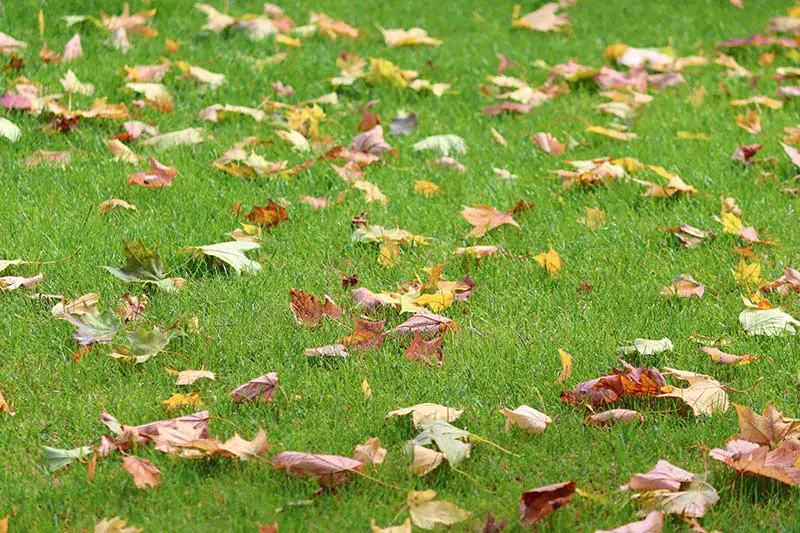
How Often Should You Mow Leaves In Fall?
You should aim to mow your lawn around once per week when the leaves start falling from your trees. Regular weekly mowing will ensure that you tackle the leaves before they have a chance to pile up in too thick a layer. This will also allow you to shred the leaves in as few passes of the mower as possible.
If you let the leaves pile up for too long, it will require more passes of the mower to shred the leaves small enough for proper decomposition. This is why it’s important to stay on top of your leaf mowing routine throughout the fall.
How to Mow Over Leaves for Best Results
Follow this method to mow over the leaves in your lawn to get the best results for your grass.
1. Prepare Mower
Firstly, you need to prepare the mower you’re going to use to mulch the leaves. The best type of mower to use for this job is a specialized mulching mower. If you can afford one, mulching mowers are a worthwhile investment for this purpose. They are specially designed with sharp blades that run at a high speed to cut the leaves into small pieces.
If you can’t afford to purchase a mulching mower, the next best option is to use a regular mower fitted with mulching blades instead. You should be able to purchase mulching blades for your particular mower model from your local garden store.
Although it’s preferable to use a mulching mower or specialized mulching blades, a regular mower with regular blades will still do the job. Set the mower deck height to its highest setting and remove any bagging attachments.
In the case that you’re using a mower or mower blades you already own, ensure the blades are sharp. Sharp blades are essential for mowing of any kind, especially when mulching fallen leaves; this ensures the leaves are chopped up as finely as possible, which in turn prevents smothering your grass. You can either sharpen your blades yourself using a hand file, or have a professional sharpen them for you.
2. Centralize Leaves From Other Areas on Lawn
Follow this step if there are leaves on nearby garden beds or on other parts of your yard that you want to remove. Use a rake or leaf blower to blow the leaves so that they’re all gathered on the lawn.
3. Mow Leaves
After you have prepared your mower and centralized the leaves onto the lawn, you’re ready to start mowing. Mow the lawn using the same pattern as you usually would in your regular mowing routine. You want to aim to shred the leaves into dime-sized pieces of about ¾ inches in size. If the leaves are wet from irrigation or rain, avoid mowing until they are completely dry; wet leaves can clog your mower, which may cause it to die.
Depending on the volume of leaves, it may take more than one pass to shred them down to this size. If the layer of leaves is more than 2 inches thick, we recommend concentrating the leaves into rows before mowing; use a leaf blower or a rake to gather the leaves in long rows, then pass the lawn mower over the rows several times. This will save you time that you would otherwise spend walking up and down the yard to cut all the leaves to size.
4. Spread Shredded Leaf Pieces
When you’ve mowed the leaves down to ¾ inch pieces, make sure they’re spread evenly across the lawn. If the pieces have mounded up on the grass to the point they’re smothering it completely, use a rake or leaf blower to disperse them more evenly around the lawn.
Alternatively, you could disperse the leaves by mowing over the large piles again, keeping the side chute of your mower open. The suction and the wind that this creates will help to spread the leaves around without you needing to use your rake.
5. Fertilize Lawn or Garden
Finally, give your leaf mulch a boost of nutrients by fertilizing the lawn after completing the previous steps. This will help the microbes in the soil to break down the shredded leaves and kickstarts the decomposition process.
Following a proper fertilization schedule, this should be the last fertilization you carry out before winter. This last fertilization is beneficial to give your grass all the nutrients it needs to survive winter and to green back up in spring.

